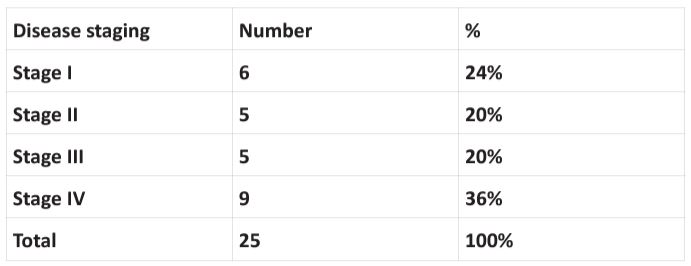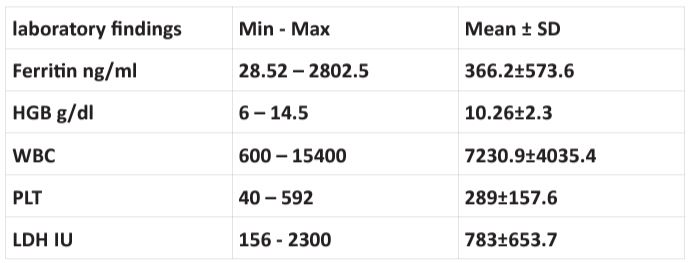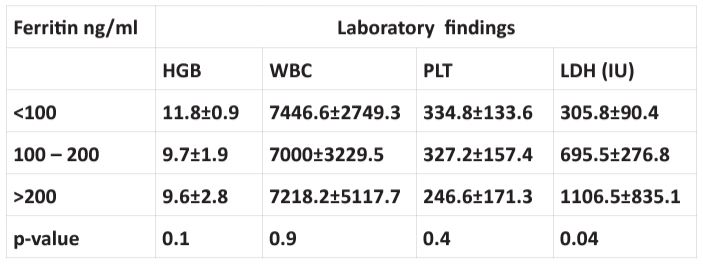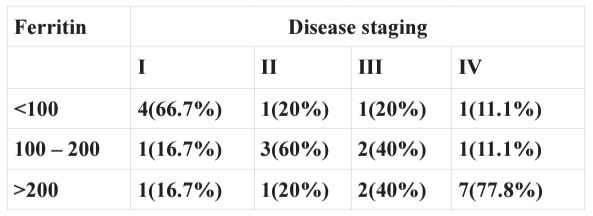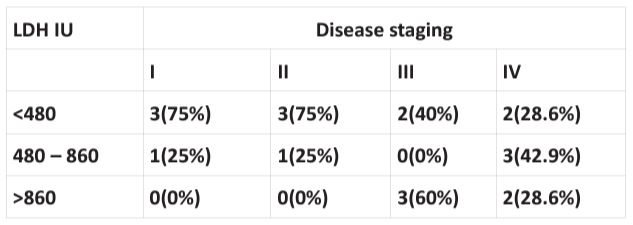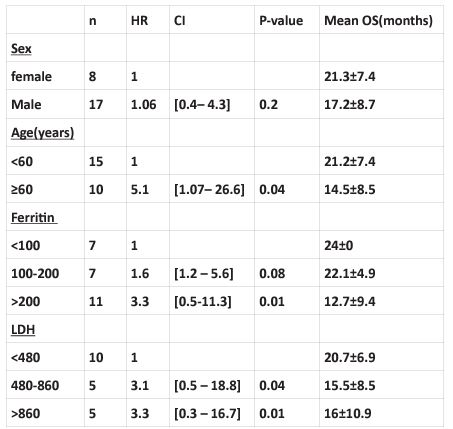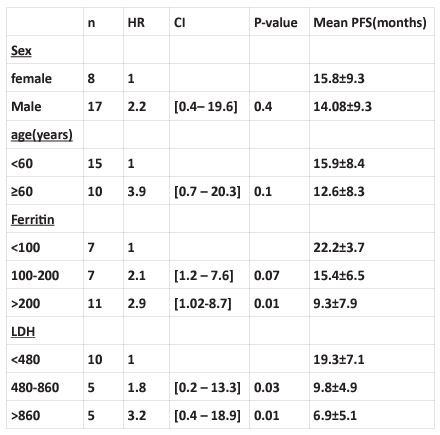Research article - Volume 4 - Issue 2
Prognostic value of both pretreatment serum ferritin and serum lactate dehydrogenase in patients with Diffuse Large B Cell Lymphoma
Firas Hussein*
Department of Clinical Hematology, Tishreen University hospital. Lattakia, Syria.
Received Date : Jan 29, 2024
Accepted Date : Feb 27, 2024
Published Date: Mar 05, 2024
Copyright: © Hussein F 2024
*Corresponding Author : Ruijie Li The First Department of Cardiology, The First Affiliated Hospital of Kunming Medical University, Kunming, China.
Email: liruijie@ydyy.cn
DOI: Doi.org/10.55920/2771-019X/1642
Abstract
Background: Several studies have shown the association between high pretreatment serum ferritin and poor prognosis in many malignancies, others studies have shown that LDH enzyme reflects the degree of cellular growth and its increase before treatment is associated with a decrease in overall survival in patients with lymphomas, especially aggressive non-Hodgkin lymphoma. Which prompted us to study the prognostic value of these parameters in patients with diffuse large B cell lymphoma.
Aim of study: studying the effect of both pre-treatment serum ferritin, serum LDH on overall survival (OS), progression-free survival (PFS) and mortality rate for 24 months in patients with DLBCL.
Materials and methods: A prospective study included 25 newly diagnosed DLBCL patients according to the histopathology and the immunohistochemistry study before starting chemotherapy according to regimen R-CHOP in the chemotherapy department at Tishreen University Hospital in Lattakia-Syria between May 2015and May 2016 and meet the entry criteria for the study. Patients were followed up for 24 months from the end of sample collection, after obtaining informed consent from them. Serum LDH was also titrated before treatment by kinetic enzyme assay in addition to ferritin baseline with an immunoassay. The studied variables that were analyzed in this study included age, gender, staging of the disease according to Ann Arbor (I-IV classification), the presence of a tumor mass Bulky <10 cm, complete blood count (CBC).
Results: The research sample was distributed according to the stage of disease in a manner close to all stages; the highest was at Stage IV by 36%. Mean serum ferritin (366.2 ± 573.6) ng/ml, mean serum LDH (783 ± 653.7) IU, mean hemoglobin (10.26 ± 2.3) g/dl, mean leukocytes (7230.9 ± 4035.4), mean platelet count (289 ± 157.6). The mean overall survival time (OS) for the whole sample was (18.5 ± 8.4) months, and the mean progression free survival (PFS) was (14.6 ± 8.4) months. The overall survival (OS) rate for 24 months was (17 patients) 68%, and the progression free survival (PFS) for 24 months was (9 patients) 36%. The increase in pre-treatment serum ferritin was accompanied with bad prognosis by 3 times risk rate, where the mean (OS) and (PFS) were respectively (12.7 ± 9.4) months and (9.3 ± 7.9) months in patients with pre- treatment serum ferritin higher than 200 ng / ml compared to (24 ± 0) and (22.2 ± 3.7) months in patients who had pre-treatment serum ferritin Less than 100 ng / ml, (p-value = 0.01). The increase in pre-treatment serum LDH was accompanied by a poor prognosis at a severity rate of 3 times where the mean (OS) and (PFS) were respectively (16 ± 10.9) months and (6.9 ± 5.1) months in patients with serum LDH values more than twice the normal compared to (20.7 ± 6.9) months and (19.3 ± 7.1) months in patients with serum LDH values within normal limits (p-value = 0.01). Where we found that elevated pre-treatment serum ferritin and elevated pre-treatment serum LDH were equivalent to the prognostic value of DLBCL patients.
Conclusions: High pre-treatment serum ferritin concentrations more than 200 ng / ml and high serum LDH can be an important independent indicator for poor prognosis in patients with DLBCL.
Key words: pre-treatment serum ferritin, pre-treatment serum LDH, DLBCL
Introduction
Diffuse Large B cell lymphoma comprise 30-58% of non-Hodgkin's lymphomas. The incidence in Europe is estimated at 3.8 / 100,000 / year. Its incidence increases with age and varies from one region to another. Among the risk factors associated with the occurrence of diffuse large cell B lymphoma are : family history of lymphoma, autoimmune diseases, HIV induced acquired immunodeficiency, hepatitis C, large body mass such as youth patients and occupational exposure to toxins And radioactive agents (1-3). There are important prognostic differences in patients with diffuse large B cell lymphoma, many clinical prognostic systems and predictive factors have been studied and developed to reach the best prognostic classification and thus the optimal treatment strategy for DLBCL patients. (4). Some studies have shown that pretreatment serum ferritin levels correlate with tumor mass and disease activity in patients with hematologic malignancies such as lymphomas and acute leukemia (5-8 ).Other Studies have also shown that elevated serum ferritin levels in cancer patients is associated with a poor prognosis. One study indicated elevated pretreatment serum ferritin levels is also associated with poor prognosis in pancreatic cancer patients (9). In patients with squamous cell carcinoma of the head and neck, ferritin levels also showed a tendency to rise and remain at high levels in patients with poor prognosis (10).In addition, recent studies indicate that higher levels of pretreatment serum ferritin in patients with allologous stem cell transplantation are associated with a higher mortality rate and lower overall survival rate (OS). In addition, other studies have shown an association between elevated levels of serum ferritin and the overall survival rate (OS) or progression-free survival rate (PFS) in patients with autologous stem cell transplantation in patients with lymphoma (11-14). Lactate dehydrogenase is an enzyme present in all tissues of living organisms including plants and animals.LDH enzyme is elevated in muscle damage, hemolytic anemia, acute coronary syndrome, infectious diseases, inflammatory diseases and malignancies. Those with elevated serum LDH levels at diagnosis had a lower overall survival rate(OS) compared to those with normal LDH levels, so LDH was a component of the international prognosis index (IPI). Serum LDH is an important predictor for prognosis in patients with aggressive NHL. However, the role of serum LDH during diagnosis, during chemotherapy and after treatment is not clearly defined. For clinicians, an increase in serum LDH or remaining elevated during or after effective treatment may indicate a poor therapeutic response or early relapse and progression of the disease (15-16).
Research materials and methods
A prospective cross-sectional - analytical study. This research included 25 DLBCL patients who were newly diagnosed according to the histopathology and the immunohistochemistry study before starting chemotherapy in the chemotherapy department at Tishreen University Hospital in Lattakia-Syria between May 2015and May 2016 and meet the entry criteria for the study. Study entry criteria included patients 18 years of age or older and previously untreated patients who will undergo chemotherapy according to a standardized R-CHOP regimen. Study exclusion criteria included patients under 18 years of age, patients who received previous chemotherapy, patients who did not have all the information and data required for research, patients who have hyperthermia from an infectious source confirmed during diagnosis, patients with iron deficiency anemia diagnosed within the six months preceding the diagnosis, patients who have acute or chronic hemolysis during diagnosis, patients with previously diagnosed myopathies or autoimmune diseases and patients with known acute coronary syndrome within the month prior to diagnosis. Patients were followed up for 24 months from the end of sample collection, after obtaining informed consent from them. Patients were subjected to a complete blood count (CBC) before chemotherapy to obtain hemoglobin, platelet and leukocyte counts, in addition to routine biochemical examinations of kidney and liver functions, inflammatory markers and serum CRP. Serum LDH was also titrated before treatment by kinetic enzyme assay in addition to ferritin Baseline before treatment with an immunoassay. Patients also had completed radiological examinations and bone marrow biopsy to determine the stage of disease and to determine the presence of a large tumor mass (Bulky Disease). Data and analyzes were collected from the patients' files after their completion and were organized into tables. We evaluated the prognostic value of baseline serum ferritin and serum LDH in patients with DLBCL through a study of overall survival (OS), progression –free survival rate (PFS) and rate of deaths. Overall survival (OS) was calculated from the date of diagnosis to the date of death, whatever the cause or to the date of the final study( 24 months), and the progression –free survival rate (PFS) was calculated from the date of starting treatment to the date of disease progression or relapse after the therapeutic response during the 24-month period. The studied variables that were analyzed in this study included age (younger or equal to 60 years, older than 60 years), gender (male, female), staging of the disease according to Ann Arbor (I-IV classification), the presence of a tumor mass Bulky <10 cm, and complete blood count (CBC). The association between these variables and both serum ferritin and serum LDH was studied. The patients were divided into three groups according to baseline serum ferritin (ferritin less than 100 ng / ml - serum ferritin between 100-200 ng / ml - serum ferritin more than 200 ng / ml) noting that the normal values for ferritin are (30-400) ng / ml in men and (13-150) ng / ml in women. The association between each group was studied with each of the studied variables, PFS, OS and mortality rate. The patients were divided into three groups according to the baseline serum LDH (LDH less than 480 IU (normal), LDH from 480-860 IU -LDH over 860 IU) and the association between each group was studied with each of the studied variables, PFS, OS and the mortality rate. The following statistical programs were used: Descriptive statistics (central tendency scale - dispersion scale - frequencies - percentages) and inferential statistics composed of student test independent to compare two arithmetic means, chi-square test to study the relationship between qualitative variables, survival was studied using survival curves For Kaplan-Meier, a multivariate Cox Hazard analysis model was used to identify the independent prognostic factors related to OS, PFS, and bad prognosis. The differences at the P-value less than 0.05 were statistically significant. The program adopted IBM SPSS Statistics (version 20).
Figure 1: OS among patients according to pre-trartement serum Ferritin
Figure 2: OS among patients according to pre-trartement serum LDH.
Figure 3: PFS among patients according to pre-trartement serum Ferritin
Figure 4: PFS among patients according to pre-trartement serum Ferritin
Table (1): Distribution of a sample of 25 lymphoma patients according to age groups
Table (2): Distribution of a sample of 25 lymphoma patients according to the stage of the disease
Table (3): The mean values of laboratory findings in lymphoma patients.
Table (4): the mean values of laboratory sensors in lymphoma patients according to the different groups of serum ferritin
Table 5: The relationship between the stage of disease and serum ferritin levels in lymphoma patients.
Table 6: The relationship between the presence of Bulky mass and the values of serum ferritin in lymphoma patients.
Table (7): the mean values of laboratory findings in lymphoma patients according to the different groups of serum LDH.
Table 8: The relationship between disease stage and serum LDH values in lymphoma patients.
Table (9): relationship between the presence of Bulky disease and serum LDH values in lymphoma patients
Table (10): Univariate cox-regression analysis of studied variants for OS in lymphoma patients.
Table (11): Univariate cox-regression analysis of the studied variants for PFS in lymphoma patients
Figure 3: CTA on admission.
Characteristics of the study sample:
The sample included 25 patients (17 males 68%, 8 females 32%) of DLBCL patients attending Tishreen University Hospital and its Oncology Center in Lattakia during the 2015-2016 period .The ages of the study sample patients ranged from 24 to 79 years, with a mean age of 55 years .The average overall survival (OS) for the whole sample was (18.5 ± 8.4) months, and the median progression survival free (PFS) was (14.6 ± 8.4) months .We notice from the table (1) that 60% of the studied research sample were in the age group less than 60 years old. We notice from the table (2) that the research sample according to the stage of the disease was distributed closely between all stages, and the highest was at Stage (IV) by 36%.
The relationship between serum ferritin and laboratory findings
The relationship between each of the studied laboratory findings and the serum ferritin values was studied through the One Way Anova test. It was found that there were no statistically significant differences for all laboratory findings in the different groups of serum ferritin except for the LDH values, which were increasing with the increase in the serum ferritin value as shown in table(4) .
The relationship between serum ferritin and the stage of disease
The relationship between stage of disease and serum ferritin values was studied by Fisher exact test showing a statistically significant relationship with (p-value = 0.03). It is noticed that stage I of disease was higher (66.7%) in patients group with serum ferritin values less than 100 ng/mg, and on the contrary, stage IV was higher (77.8%) in patients group with serum ferritin values greater than 200ng/ml, as shown in table (5).
The relationship between serum ferritin and the presence of bulking mass
The relationship between the presence of Bulky mass and the values of serum ferritin was studied through the Fisher exact test showing that there was no statistically significant relationship with( p-value = 0.7). However, we noted that the bulky mass was higher (55.6%) in patients group with baseline serum ferritin more than 200 ng/ml, as shown in table (6).
Relationship between baseline serum LDH and laboratory findings
The relationship between each of the laboratory findings and serum LDH values was studied through the One Way Anova test. It was found that there were no statistically significant differences for all laboratory findings, noting that there was an increase in serum ferritin values and an decrease in hemoglobin concentration, leukocytes and platelets count in group III (LDH>860) compared to group I (LDH<480) as shown in table (7).
The relationship between baseline serum LDH and the stage of disease
The relationship between disease stage and serum LDH values was done by Fisher exact test showing a statistically significant relationship, (p-value = 0.04). It is found that an increase of serum LDH more than 480 UI was mostly associated with advanced stage (III, IV) as shown in table(8).
The relationship between serum LDH and the presence of bulky disease
The relationship between the presence of Bulky disease and the values of serum LDH was studied by Fisher exact test showing no statistically significant relationship (p-value = 0.5), but it was found that 71.5% of cases with serum LDH values more than 480 represented Bulky disease.
Study the overall survival of the study sample (OS) and the relationship with prognostic factors
We noticed an effect of advanced age, elevated serum ferritin values, and elevated serum LDH values on survival rates (OS) with statistically significant differences, as advanced age is associated with a risk rate of 5 times, while an increase in both serum ferritin more than 200ng/ ml and elevated LDH values is associated with risk rare of 3 times (Figure1 and 2). Multivariate Cox Hazard analysis was used to identify the independent prognostic factors associated with OS in lymphoma patients , the elevation of serum ferritin was strongly associated with a poor prognosis for patients, HR = 2.9 [0.1-7.8],(P-value = 0.02).
Study of the overall disease-free survival of the study sample (PFS) and the relationship with prognostic factors
Our study revealed an effect of both high serum ferritin and high serum LDH values on PFS rates, with statistically significant differences. An increase in both serum ferritin more than 200 ng/ml and an increase in LDH values more than 860 uN/L was associated with risk rate of 3 times (Figure3 and 4 ). Multivariate Cox Hazard analysis was used to identify the independent prognostic factors associated with PFS in patients with diffuse large B cell lymphoma. An elevation of serum ferritin more than 200 ng/ was strongly associated with a poor prognosis, HR = 2.5 [1.2-6.2], (p-value = 0.01).
Studying the relationship between the studied variables and the occurrence of death
Death occurred in 8 cases, accounting for 32% of the total sample studied. The relationship between the values of serum ferritin. serum LDH values and the incidence of death was studied by an Independent T Student test, showing statistically significant differences, noting that the values were more higher in the mortality group
Discussion
The sample included 25 patients (17 males, 8 females) of DLBCL patients .The ages of the research sample patients ranged from 24 to 79 years, with an average age of 55 years, as 60% of the research sample studied were in the age group less than 60 years. The research sample was distributed according to the stage of disease in a manner close to all stages; the highest was at Stage IV by 36%. Mean serum ferritin (366.2 ± 573.6) ng/ml, mean serum LDH (783 ± 653.7) IU, mean hemoglobin (10.26 ± 2.3)G/g/dl, mean leukocytes (7230.9 ± 4035.4), mean platelet count (289 ± 157.6). The mean overall survival time (OS) for the whole sample was (18.5 ± 8.4) months, and the average period of progression free survival (PFS) was (14.6 ± 8.4) months. The overall survival (OS) rate for 24 months was (17 patients) 68%, and the progression free survival (PFS) for 24 months was (9 patients) 36%.
We studied the prognostic factors associated with a two-year overall survival rate (OS) in patients with diffuse large B cell lymphoma. The effect of sex, age, pre-treatment serum ferritin, pre-treatment serum LDH value were studied and the effect of the treatment regimen was not studied because all patients were treated according to R-CHOP regimen (4-8 courses depending on the stage of disease). This study concluded that there was no statistically significant relationship between the patient's gender and the overall survival (OS), with regard to age, age progression was accompanied with worse prognosis by a 5 times risk rate, where the mean overall survival was (14.5 ± 8.5) months for patients over 60 years of age compared to (21.2 ± 7.4) months for patients under 60 years of age, (p-value = 0.04). The increase in pre-treatment serum ferritin was accompanied with bad prognosis by 3 times risk rate, where the mean overall survival (OS) was (12.7 ± 9.4) months in patients with pre- treatment serum ferritin higher than 200 ng / ml compared to (24 ± 0) months in patients who had pre-treatment serum ferritin Less than 100 ng / ml,( p-value = 0.01). The increase in pre-treatment serum LDH was accompanied by a poor prognosis at a severity rate of 3 times where the mean overall survival (OS) was (16 ± 10.9) months in patients with serum LDH values more than twice the normal compared to (20.7 ± 6.9) months in patients with serum LDH values within normal limits,( p-value = 0.01). Where we found that elevated pre-treatment serum ferritin and elevated pre-treatment serum LDH were equivalent to the prognostic value of overall survival (OS) in patients with diffuse large B cell lymphoma with a severity rate of 3 times, ( p-value = 0.01). Multivariate Cox Hazard analysis was also used to identify the independent prognostic factors associated with (OS) in lymphoma patients. An elevation of pre-treatment serum ferritin was strongly associated with poor prognosis for patients, HR = 2.9 [0.1-7.8] , (p-value = 0.02). This agree with the results of the study conducted by Kyung Ah Yoh et al, (17) where he identified the most important prognostic factors associated with the overall survival for 5 years in lymphoma patients, including: Age over 60 years, where the overall survival rate was (60.9%) at ages under 60 years versus ( 36.9%) at ages over 60 years. Increased pre-treatment serum ferritin, where the overall survival rate was (57.5%) in patients with serum ferritin less than 500 ng / ml compared to (11.6%) in patients with serum ferritin greater than 500 ng / ml. Serum LDH, where the overall survival rate was (69.5%) in patients with pre-treatment serum LDH less than normal compared to (29.4%) in patients who had pre-treatment serum LDH above normal limits.).
We also studied prognostic factors associated with the two-year progression-free survival rate (PFS) in patients with (DLBCL). The effect of sex, age, pre –treatment serum ferritin, and pre –treatment serum LDH value were studied. Our study concluded that there was no effect of the patient’s sex and age on PFS, and an increase in pre –treatment serum ferritin was accompanied by bad prognosis at risk rate of 3times, the mean PFS was (9.3 ± 7.9) months in patients with pre –treatment serum ferritin higher than 200 ng / ml versus (22.2 ± 3.7) months in patients with pre –treatment serum ferritin less than 100 ng / ml, (p-value = 0.01). The increase in pre –treatment serum LDH was associated with a poor prognosis at a severity rate of 3 times, where the mean PFS was (6.9 ± 5.1) months in patients with pre –treatment serum LDH values more than twice the normal compared to (19.3 ± 7.1) months in patients who they had pre –treatment serum LDH values within normal limits, (p-value = 0.01). Where we also found that elevated pre-treatment serum ferritin and pre-treatment elevated serum LDH were equivalent to the prognostic value of total survival free from progression of PFS in patients with diffuse large cell B lymphoma at a severity rate of 3 times, (p-value = 0.01). Multivariate Cox Hazard analysis was also used to identify the independent prognostic factors associated with PFS in patients with diffuse large B cell lymphoma. An elevation of pre-treatment serum ferritin was strongly associated with a poor prognosis, HR = 2.5 [1.2-6.2], (p-value = 0.01). In his study, Kyung Ah Yoh (17) and colleagues identified the most important prognostic factors associated with the mean progression free survival (PFS) for 5 years in lymphoma patients in general: including the rituximab-based chemotherapy versus chemotherapy without rituximab, B or T cell lymphoma, IPI, elevated pre-treatment serum LDH, stage of disease, pre-treatment serum CRP, involvement of bone marrow and elevated pre-treatment serum ferritin. This is consistent with our study with regard to, elevated pre-treatment serum LDH and elevated pre-treatment serum ferritin, noting that we studied a homogeneous sample with respect to the histological type of lymphoma and the chemotherapy protocol that we used R-CHOP regimen, but we did not study pre-treatment serum CRP, bone marrow involvement and IPI.From the above, our study showed that pre-treatment serum ferritin and pre-treatment serum LDH have the same prognostic value in terms of overall survival (OS) and progression free survival (PFS) in patients with DLBCL. our study is in agreement with the study that Kim and colleagues conducted in a review of 312 patients with low-risk large B cell lymphoma where it showed that elevated serum ferritin levels more than 500 ng / mL is an independent prognostic factor for PFS and OS for 5 years in patients with IPI Low risk, and IPI cannot accurately predict risk in patients with low-risk diffuse large B cell lymphoma (DLBCL) (18). This also agree with the study that Herve and colleagues conducted in 87 patients with (DLBCL), where the two-year overall survival (OS) rate was( 69%) in patients with pre-treatment serum ferritin more than 466 mcg / L versus (88%) in patients with normal ferritin, (p = 0.04). The rate of PFS was( 58%) versus (75%) in patients with normal ferritin (p = 0.09), without a correlation between pre-treatment serum ferritin and response rate at the end of the treatment protocol (19).Our study is also agree with the study conducted by Junshik Hong and colleagues, it was shown that high pre-treatment LDH is a strong predictive factor for bad prognosis, as it is associated with a low overall survival rate (OS) and low progression-free survival rate (PFS) (20). We studied prognostic factors associated with mortality rate in patients with (DLBCL). Both pre-treatment serum ferritin and, pre-treatment serum LDH were studied. Independent T Student tests were used for this study. The death occurred in 8 cases, (32%) of the total research sample studied. The relationship between the values of serum ferritin and the occurrence of death was studied, it was found that there were statistically significant differences, noting that the average value of ferritin was (749.4 ± 872.1) ng / ml in the mortality group compared to (185.8 ± 229.6)ng / ml in the alive group,( p- value = 0.01). The relationship between serum LDH values and the occurrence of death was also studied, and statistically significant differences were found, noting that the mean LDH value was (1038.1 ± 819.6) in the mortality group compared to (645.7 ± 531.4) in the alive group, (p-value = 0.02). Thus, both pre-treatment serum ferritin and pre-treatment serum LDH are associated with mortality rate.
Conclusion
High pre-treatment serum ferritin concentrations more than 200 ng / ml can be an important independent indicator for predicting poor overall survival (OS) and poor progression free survival (PFS) in patients with diffuse large B cell lymphoma. The prognostic value of pre-treatment serum ferritin is equal to that of pretreatment serum LDH for each overall survival (OS) and progression-free survival (PFS). Both the pre-treatment serum ferritin and the serum LDH correlate with the staging of disease and mortality rate in DLBCL patients.
Abbreviations:
LDH: lactate dehydrogenase-
OS: overall survival-
Progression-free survival PFS:-
-DLBCL: diffuse large B cell lymphoma.
R-CHOP: rituximab, cyclophosphamide, hydriamycin,.oncovin ,prednisolone -
IPI: international prognosis index -
NHL: non -Hodgkin’s lymphoma
-CBC: complete blood count
CRP: C reactive protein-
- WBC:whithe blood cells
-HGB: blood Hemoglobin concentration
-PLT: Platelets count
Declarations
Ethics approval and consent to participate
Written consent was obtained for the patients to participate in the study, written informed consent was obtained from a parent for participants under 18 years old. Our institutional ethics committee in the faculty of medicine- Tishreen University approved our study .
Consent for publication: written consent to publish this information was obtained from study participants.
Availability of data and materials: All data generated or analyzed during this study are included in this published article [and its supplementary information files].
Competing interests: no conflict of interest
Funding: no funding was received
Authors' Contributions: Corresponding author analyzed and interpreted the patient data.
Acknowledgements: Not applicable
References
- Sant M, Allemani C, Tereanu C et al. Incidence of hematologic malignancies in Europe by morphologic subtype: results of the HAEMACARE project. Blood 2010; 116: 3724–3734.
- Morton LM, Slager SL, Cerhan JR et al. Etiologic heterogeneity among non- Hodgkin lymphoma subtypes: the InterLymph Non-Hodgkin Lymphoma Subtypes Project. J Natl Cancer Inst Monogr 2014: 130–144.
- Sant M, Minicozzi P, Mounier M et al. Survival for haematological malignancies in Europe between 1997 and 2008 by region and age: results of EUROCARE-5, a population-based study. Lancet Oncol 2014; 15: 931–942.
- International Non-Hodgkin’s Lymphoma Prognostic Factors Project A predictive model for aggressive non-Hodgkin’s lymphoma. N Engl J Med. 1993; 329(14): 987-994.
- Aulbert E, Fromm H, Hornemann H. Ferritin in acute leukemia. Serum ferritin concentration as a nonspecific tumor -marker for M1 and M2 myeloid leukemia [in German]. Med Klin (Munich) 1991; 86:297-3045.
- Aulbert E, Steffens O. Serum ferritin a tumor marker in malignant lymphomas? [in German]. Onkologie1990; 13:102-8.
- Matzner Y, Konijn AM, Hershko C. Serum ferritin in hematologic malignancies. Am J Hematol1980; 9:13-22.
- Eshhar Z, Order SE, Katz DH. Ferritin, a Hodgkin s disease associated antigen. Proc Natl Acad Sci U S A1974; 71:3956-60.
- Kalousová M, Krechler T, Jáchymová M, et al. Ferritin as an independent mortality predictor in patients with pancreas cancer. Results of a pilot study. Tumour Biol2012; 33:1695-700.
- Maxim PE, Veltri RW. Serum ferritin as a tumor marker in patients with squa- mous cell carcinoma of the head and neck. Blood2 Cancer1986; 57:305-11.
- Lim ZY, Fiaccadori V, Gandhi S, et al. Impact of pre-transplant serum ferritin on outcomes of patients with myelodysplastic syndromes or secondary acute myeloid leukaemia receiving reduced intensity conditioning allogeneic haematopoietic stem cell transplantation Leuk Res2010; 34:723-7.
- Alessandrino EP, Porta MGD, Bacigalupo A, et al. Prognostic impact of pre-transplantation transfusion history and secondary iron overload in patients with myelodysplastic syndrome undergoing allogeneic stem cell transplantation: a GITMO study. Haematologica2010; 95:476-84.
- Armand P, Kim HT, Cutler CS, et al. Prognostic impact of elevated pre- transplantation serum ferritin in patients undergoing myeloablative stem cell transplantation007; 109:4586-8.
- Storey JA, Connor RF, Lewis ZT, et al. The transplant iron score as a predictor of stem cell transplant survival. J Hematol Oncol2009; 2:44.
- A predictive model for aggressive non-Hodg- kin’s lymphoma. The International Non- Hodgkin’s Lymphoma Prognostic Factors Project. N Engl J Med 1993; 329: 987–994.
- Blay J, Gomez F, Sebban C, Bachelot T, Biron P, Guglielmi C, Hagenbeek A, Somers R, Chauvin F, Philip T: The International Prog nostic Index correlates to survival in patients with aggressive lymphoma in relapse: analysis of the PARMA trial. Parma Group. Blood 1998; 92: 3562–3568.
- Kyung Ah Yoh et al, The Prognostic Signi ficance of Elevated Levels of Serum Ferritin Before Chemotherapy in Patients With Non-Hodgkin Lymphoma. Clinical Lymphoma, Myeloma & Leukemia, 2014,Vol. 14, No. 1, 43-9.
- (Kim, D.J., Kim, T., Jeong, J. et al. Poor prognostic impact of high serum ferritin levels in patients with a lower risk of diffuse large B cell lymphoma. Int J Hematol 111, 559–566 (2020). https://doi.org/10.1007/s12185-019-02816-6).
- Herve Ghesquieres et al , Prognostic Impact of Elevated Serum Ferritin at Diagnosis of Diffuse Large B-Cell Lymphoma Treated In the Rituximab Era . Blood (2010) 116 (21): 5080. https://doi.org/10.1182/blood.V116.21.5080.5080
- Junshik Hong et al . Prognostic Role of Serum Lactate Dehydrogenase Beyond Initial Diagnosis: A Retrospective Analysis of Patients with Diffuse Large B Cell Lymphoma. Acta Haematol 2013;130:305–311 . DOI: 10.1159/000353127.






